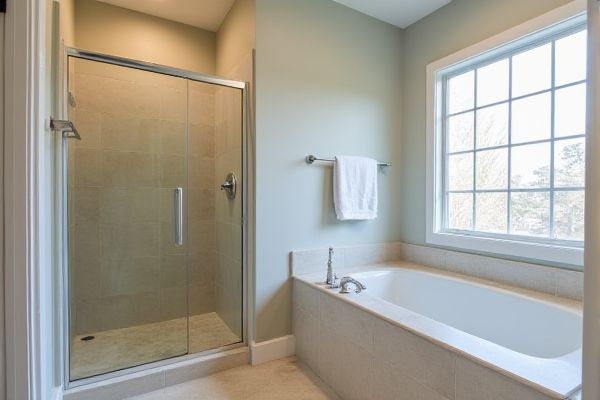
A walk-in shower offers a sleek, modern design with easy accessibility and efficient use of bathroom space, while a tub shower combo provides versatility for both soaking and quick showers, ideal for families or those who enjoy relaxation. Discover the key differences and benefits of each option to determine which best suits Your lifestyle in the full article.
Table of Comparison
| Feature | Walk-in Shower | Tub Shower Combo |
|---|---|---|
| Space Efficiency | Compact, maximizes bathroom space | Requires more space due to tub size |
| Accessibility | Easy entry, ideal for mobility issues | High walls, less accessible |
| Cleaning & Maintenance | Simple to clean, fewer crevices | More surfaces, requires effort |
| Functionality | Best for quick showers | Dual use: bathing and showering |
| Installation Cost | Generally lower cost | Higher cost due to tub and plumbing |
| Aesthetic Appeal | Modern, sleek look | Traditional, classic appearance |
| Water Usage | Lower water consumption | Higher water usage for baths |
Introduction: Walk-In Shower vs Tub Shower Combo
Walk-in showers offer a sleek, modern design with easy access and spacious interiors ideal for contemporary bathrooms. Tub shower combos combine bathing and showering options, maximizing functionality in smaller spaces while providing versatility for families. Choosing between these depends on bathroom size, user preferences, and lifestyle needs.
Key Differences Between Walk-In Showers and Tub Shower Combos
Walk-in showers offer a sleek design with easy access and more space, ideal for those prioritizing convenience and modern aesthetics. Tub shower combos combine bathing and showering functions in one unit, providing versatility for families with children or those who enjoy soaking in a bath. Your choice depends on whether you value accessibility and style or multifunctional use in your bathroom setup.
Space Requirements and Bathroom Layout Considerations
Walk-in showers typically require less floor space and can make small bathrooms feel more open and accessible, making them ideal for modern, minimalist layouts. Tub shower combos demand more space to accommodate both bathing and showering functions, often limiting flexibility in compact or irregularly shaped bathrooms. Evaluating your bathroom layout and available space is essential to determine which option enhances functionality and comfort while maximizing your room's design potential.
Accessibility and Safety Features
Walk-in showers provide superior accessibility with low or no thresholds, making them ideal for individuals with mobility challenges or those using wheelchairs. Safety features such as built-in grab bars, non-slip flooring, and seating options enhance stability and reduce fall risks compared to tub shower combos, which often require stepping over a high tub edge. Tub shower combos may limit ease of entry and exit, posing safety concerns for seniors or people with disabilities.
Aesthetic Appeal and Design Flexibility
Walk-in showers offer sleek, modern aesthetics with frameless glass and customizable tile options that enhance bathroom spaciousness and light flow. Tub shower combos provide versatile functionality with classic or contemporary designs, accommodating both bathing preferences and limited space. Design flexibility in walk-in showers allows seamless integration with various decor styles, while tub combos balance practicality with traditional charm.
Installation Process and Cost Comparison
Walk-in showers typically involve a simpler installation process with fewer plumbing modifications, often resulting in lower labor costs compared to tub shower combos, which require more extensive plumbing and structural work to accommodate both tub and shower functions. The materials used in walk-in showers, such as glass panels and large-format tiles, can vary in price but usually lead to a more streamlined and cost-effective installation than the complex sealing and waterproofing needed for tub shower combos. Overall, walk-in showers generally offer a more affordable and quicker installation process, while tub shower combos tend to incur higher costs due to increased labor and material requirements.
Maintenance and Cleaning Considerations
Walk-in showers typically require less maintenance than tub shower combos due to fewer grout lines and simpler fixtures, reducing mold and mildew buildup. Tub shower combos often accumulate soap scum and water stains around the tub edges, demanding more frequent scrubbing and specialized cleaning products. Choosing materials like non-porous tiles and seamless glass doors in walk-in showers can further minimize cleaning efforts and prolong durability.
Suitability for Families, Seniors, and Individuals
Walk-in showers offer easy access and safety features, making them ideal for seniors and individuals with mobility challenges, while tub shower combos provide versatility for families needing both bathing and showering options. Families benefit from the tub's ability to accommodate young children for baths, whereas walk-in showers save space and require less maintenance. Seniors prefer walk-in showers due to the low threshold and grab bar compatibility, reducing the risk of slips and falls.
Impact on Home Value and Resale Potential
Walk-in showers often elevate home value by appealing to modern buyers seeking sleek, accessible designs, while tub shower combos cater to families preferring versatility, enhancing resale potential in family-centric markets. Your choice should align with local buyer preferences and neighborhood trends to maximize return on investment. Homes featuring walk-in showers typically attract higher appraisals in upscale areas, whereas properties with tub shower combos maintain broader appeal in diverse markets.
Making the Right Choice: Factors to Consider
Selecting between a walk-in shower and a tub-shower combo depends on your space, accessibility needs, and bathing preferences. Walk-in showers offer a modern, spacious design ideal for easy entry and effective water drainage, while tub-shower combos provide versatility for soaking and quick showers. Consider factors such as bathroom size, user mobility, cleaning convenience, and lifestyle habits to make the right choice for your home.
 homyna.com
homyna.com